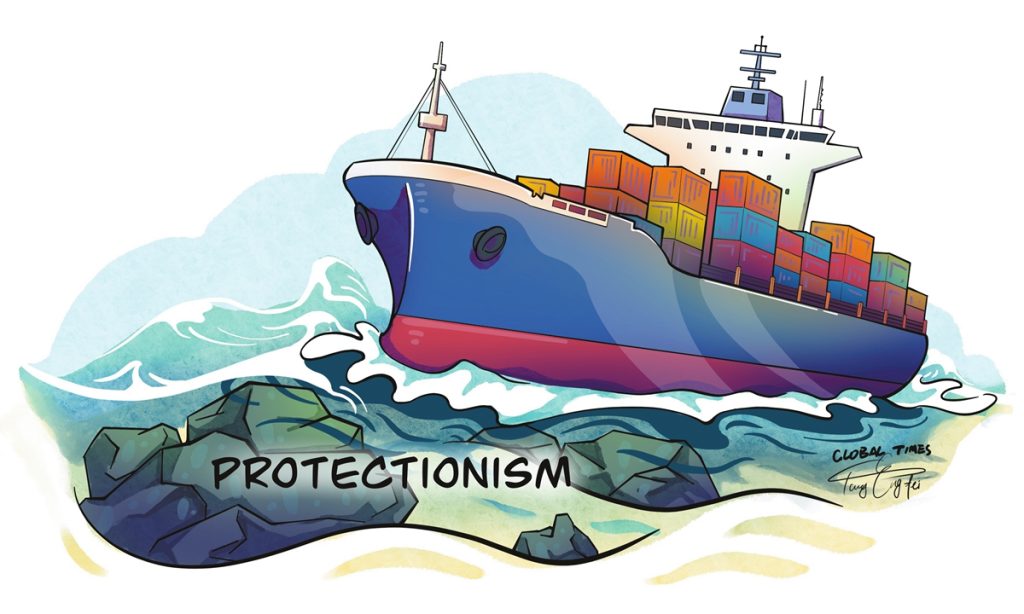US can pare trade gap by easing export curbs, not pursuing protectionism

The US trade deficit surged by 7.9 percent from the prior month to $78.8 billion in July, the highest level in more than two years. Some political elites may still have an irrational fear about a deficit in foreign trade, even though much of their anxiety is unnecessary.
Faced with a persistent trade deficit, the US has been overburdened by excessive anxiety and has adopted protectionist measures in recent years targeting certain goods imported from certain countries, including China, to whittle down imports and trade deficits. But clearly, political elites in Washington have failed to do so, as the US trade deficit continues to widen. It's a bit ironic: it is not the trade deficit that poses a risk to the US economy, but trade protectionism actions.
A closer look into the US trade deficit shows that growth in July was led by increases in US imports. US exports in July were $266.6 billion, $1.3 billion more than in June, while imports were $345.4 billion - $7.1 billion more than the previous month, official data showed. Obviously, the growth in imports exceeded that of exports, resulting in a widening trade deficit.
Analysts attribute the pickup in US merchandise imports to multiple factors. First, some importers want to get ahead of a potential dockworkers' strike as reported by some media outlets by shipping cargo into the US earlier than usual. Second, retailers have begun stocking up as they bet on a strong holiday season. That's led to a surge in imports.
The ports of Los Angeles and Long Beach, in California, which account for roughly one-third of all US container imports, had their third-strongest month ever in July, according to Bloomberg. Retailers seem to be optimistic about American consumers' spending, especially in the holiday shopping season.
This is good news for the US economy. Consumption spending makes up two-thirds of the US economy on average, so a pickup in US merchandise imports serves, to some extent, as both a consumer confidence indicator and a leading indicator that bodes well for economic growth.
More specifically for trade between China and the US, official US data showed the US deficit with China increased by $4.9 billion to $27.2 billion in July. Exports to China fell $1.0 billion while imports advanced $3.9 billion.
Some US enterprises have been stockpiling products, components and parts from China, because of uncertainty over US tariffs. According to Reuters, the Biden administration on August 30 delayed an announcement of its final determinations for tariff hikes on some Chinese-made products including semiconductors, saying it will make a decision public in the "coming days."
It seems US importers are trying to seize the time window to build inventories. It adds to evidence that made-in-China products are irresistible and irreplaceable. A complete economic "decoupling" between the two countries is impossible.
In general, a pickup in US merchandise imports is not necessarily a bad thing if it sends a signal that domestic consumption is recovering. The resulting trade deficit should not cause undue concern. If US policymakers seek to whittle down trade deficits and imports through protectionist trade measures, they will fail to solve existing problems but create new ones.
They will also disrupt normal trade and economic activities, and force American importers to reduce their losses through various means, including building inventories. Excessive anxiety toward trade deficits and Washington's response to the issue - trade protectionism - may lead to bigger problems for the US economy.
A trade deficit is an indicator that a nation consumes more than it produces. The focus should be on increasing production and exports, instead of cutting consumption and imports. The US needs to further expand exports, especially those of high-tech, high-value-added products.
China does not deliberately pursue a trade surplus and the current trade imbalance between the two countries is a result of normal market operation, which is guided by the bilateral economic structure, industry competitiveness and the international division of labor.
Based on the development of the international division of labor, the US has an advantage in the production of high-tech goods, but unfortunately, the country has in recent years embarked on a tightening of its export control rules when it comes to cutting-edge technology items such as chips.
In this sense, the most effective way for the US to reduce its trade deficit is to ease export curbs and promote exports, rather than restricting imports by adopting trade protectionist measures.